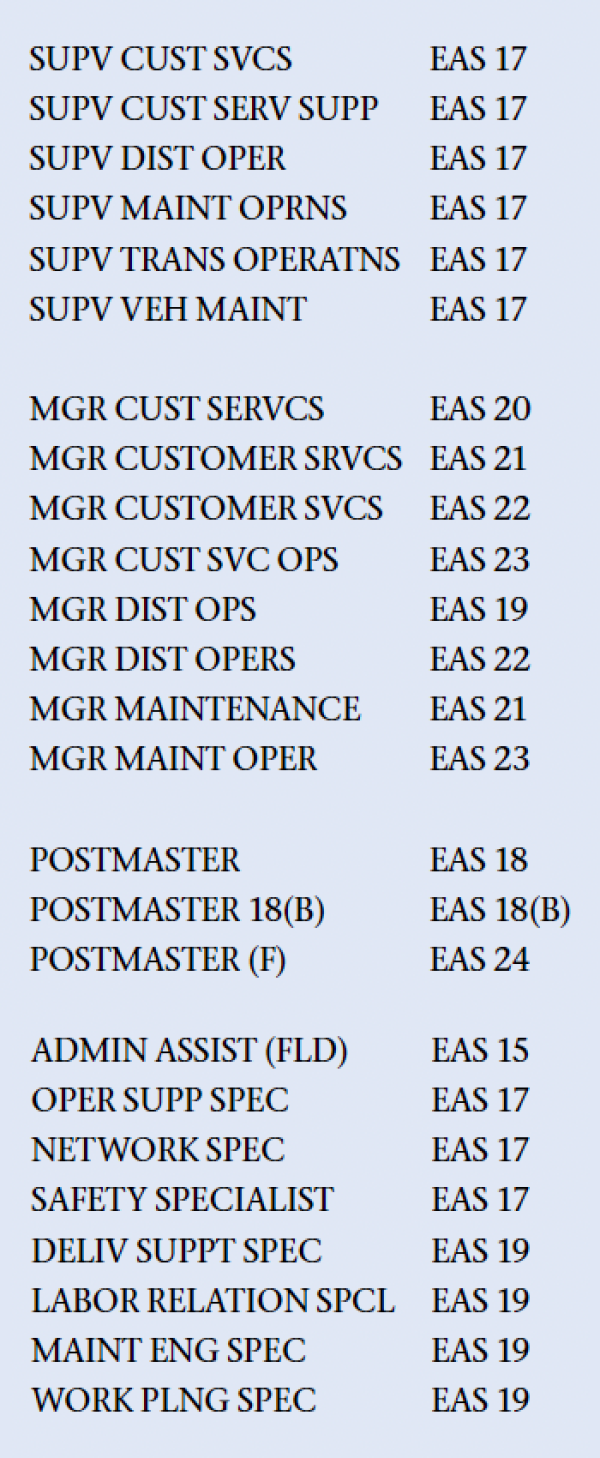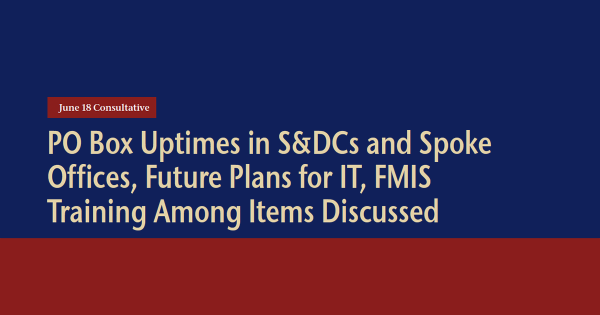June 2024 Consultative
NAPS President Ivan D. Butts, Executive Vice President Chuck Mulidore, Secretary/Treasurer Jimmy Warden and Executive Board Chair Chuck Lum attended the June 18 Zoom consultative meeting. Representing the Postal Service were Bruce Nicholson, James Timmons and Paulita Wimbush, USPS Labor Relations Policies & Programs.
Agenda Item #1
There have been multiple instances of local Illinois NAPS messages sent to district and area officials that deal largely with treatment of EAS employees that have not been addressed. This issue has been elevated to the NAPS Illini Area and Central Region vice presidents, with little success in gaining responses.
NAPS requested that the Illinois district manager, Chicago postmaster and Central Area vice president convene a call with local and national NAPS leadership to finally address these ongoing issues.
This is a local issue. These concerns should be addressed at the local level.
Agenda Item #2
NAPS addressed the issue of the number of district AMS craft/APWU specialist positions varying from district to district, with no apparent equality. Smaller districts with fewer total routes (city and rural) have more AMS craft/APWU specialist positions than larger districts.
NAPS asserted this staffing inequality creates unnecessary productivity burdens and expectations in AMS departments from district to district across the country. Example: The Wisconsin District has seven AMS craft/APWU clerks and covers maintenance on approximately 4,800 route edit books and route adjustments; the MN/ND district has six AMS craft/APWU clerks and covers maintenance on approximately 5,750 route edit books and route adjustments.
There does not seem to be a set staffing model/criterion for approving the number of AMS craft/APWU craft specialists positions per district. NAPS asked what the USPS’ staffing model/criteria is for establishing the number of district AMS craft/APWU positions per district, as well as what the process is to add or delete a district AMS craft/APWU specialist position.
The complement of bargaining-unit positions has not changed since the reorganization. We continue to monitor the staffing, including positions, once they are vacated.
Agenda Item #3
NAPS Headquarters received the attached message indicating the USPS was changing PO box “uptimes” to noon in existing, as well as future, S&DC and spoke sites. NAPS asked what the justification is for this impact to customers served at these site offices.
NAPS believes this is indicative of the inability of the USPS to address service issues associated with the S&DC implementation as part of the “Delivering for America” plan. NAPS noted that station managers, as well as postmasters, will field complaints from business customers in particular who historically have received their PO box mail early in the day.
The need to standardize PO box uptime at the S&DCs and the related spokes was due to the change in mail transport schedules and our continued effort to meet customer service expectations and needs. Adjusting the uptime to noon will not change the current PO box uptime performance, but, rather, provide a more accurate expectation for our customers. Business customers should not see an impact to mail availability compared to when mail currently is available.
Agenda Item #4
NAPS requested the state of In Plant Support (IPS) and sort plan generation/maintenance. Contractors are being given access to USPS systems and data for purposes of creating sort plans. Does the USPS have a plan to contract this out, thereby impacting EAS positions?
There are newly activated sites where the contractors and/or engineering group are handling sort programs and maintenance until the new machines/systems (HOPS and MaRS) can be fully tested. The contractors only are assisting during deployment and transition of the new machines. Local Processing Support still owns the tasks and have been/will be transitioned to responsibility of the equipment once it has been accepted by the Postal Service.
Agenda Item #5
NAPS requested a briefing on the future plans for IT. Field IT members have told NAPS Headquarters that jobs are not being posted and contractors are replacing IT specialists. What is the USPS’ plan for IT?
There is no hold on job vacancies; they are posted regularly.We are not aware of any instances of IT positions being filled by contractors.
Agenda Item #6
NAPS has been made aware that some districts in the Southern Area are using evening “bridge calls” with EAS employees to discuss topics such as scanning and clock ring errors. Data is reviewed with a postmaster who asks questions regarding missing scans and TACS errors. These calls are disguised as service calls, yet, in reality, simply are a method to intimidate EAS employees in making certain they are “not on a list.”
Having EAS employees correct clock ring errors is bargaining-unit work anyway. There have been grievances and arbitration payouts to craft unions throughout the country on this issue. Also, at times, some rings cannot be corrected until you speak to the employee. These types of tactics potentially drive poor behavior and should be stopped immediately.
This is a local issue. These concerns should be addressed at the local level.
Agenda Item #7
In the Orlando Post Office, Sand Lake Branch Station Manager David Ortona is attempting to rebid EAS employees in the station. His reasoning is he does not know his staffs’ PS Form 50 positions. Local NAPS recommended he reach out to HR local services.
In addition, NAPS provided Ortona and the Orlando Post Office with the Involuntary Reassignment Letter and was informed that, in his opinion, it does not pertain because this is a permanent change. NAPS requests that this practice be stopped and local USPS leaders not arbitrarily move EAS employees in this improper manner.
Determining scheduled days off for individual assignments is a local management function.
Agenda Item #8
At the March consultative, Agenda Item #4, NAPS asked about Fleet Management Information System (FMIS) training. Thus far, there has been no response from Fleet Maintenance. Currently, there is only one-week, onsite training. When FMIS rolled out in WestPac, it started with two weeks of onsite training.
Some VMFs have more than one shift; there is only one trainer for some VMFs with over 20 employees. The FMIS rollout has been very rocky. NAPS requested more field training asserting that Zoom calls and “Learn and Grow” sessions are not adequate.
Employees are appropriately scheduled. The current training schedule maximizes the number of VMFs able to receive onsite support from FMIS subject-matter expert (SME) trainers. VMFs can contact their designated SME with any concerns or questions following go-live, as well as the materials. customerservice@usps.gov help desk for technical issues.
The current training schedule is the result of feedback from initial training for the first sites in WestPac and maximizes the number of VMFs able to receive onsite support from FMIS SME trainers. For VMFs with more than one tour, SMEs either will train on multiple tours or two-hour changes of schedule are used to ensure all employees receive training.
For our largest VMFs, including those with three tours, multiple SMEs are on site for training. In addition to a week of onsite training, each VMF receives a week of live virtual training prior to go-live, as well as access to a live bridge call (open for 12 hours per day) for the two weeks following go-live. VMFs can contact their designated SME with any concerns or questions following go-live, as well as the materials. customerservice@usps.gov help desk for technical issues.
Agenda Item #9
As part of the consultative process, NAPS asked the Postal Service to provide the following data and information. If the Postal Service wishes, NAPS will agree to keep any and all information confidential.
Item 1: Data Regarding USPS Pay to EAS and Craft Employees
A. In order to evaluate results of the current pay program, NAPS would like to receive more detailed information regarding pay received by EAS and craft employees. As
an initial matter, please provide a description of the data the Postal Service keeps and/or can generate and/or anticipates being able to generate in the future relating to employee pay, including (1) base pay, overtime pay (including T-time, etc.) and total pay; and (2) hours covered by base pay, additional hours and total hours worked.
The Postal Service requests clarification on Request 1(A). In order for the agency to initiate fact investigation into the data requested, including a request from appropriate records custodians for a “description” of what data the Postal Service maintains relating to the requested information, please provide: (1) a time period, and (2) a list of categories of employees for whom you request this data.
B. Please provide, on a weekly basis, copies of the weekly “Flash Reports” currently received by craft/bargaining-unit employees. Additionally, please describe what data is kept by the Postal Service to compile these reports, including data on base and overtime pay, as well as data on regular and overtime hours.
The Postal Service is unaware of flash reports provided to bargaining-unit employees. In order for the Postal Service to respond to this request, we request an example report that has been provided to bargaining-unit employees and its purpose.
C. Please provide the median salaries and median total compensation for the following positions that NAPS initially requested in a March 7, 2023, letter to Bruce Nicholson and re-requested from him in a Dec. 20, 2023, letter. In a March 8, 2024, letter, USPS Managing Counsel for Labor Law Ray Donahue indicated that NAPS should request this data through the monthly consultative process.
The USPS is in the process of gathering this data.

Item 2: Information Regarding the Structure of the Postal Service and Reporting Within the Organization
A. Please provide copies of all current Postal Service organizational charts reflecting the structure and relation of employees in the Executive Service, Executive Administrative Schedule and craft positions, including organization charts referenced in Section 114 of the ELM that are maintained by Organizational Effectiveness, Employee Resource Management, at Headquarters.
B. On an ongoing basis, please provide copies of any updated organizational charts as they are created—both for contemplated changes and changes that have been implemented.
In response to Item 2, A & B, the Postal Service requests an explanation as to the relevance of this request to the consultative process.
Item 3: Information Regarding the RIFs (NAU/OVC) Announced by the USPS the Week of May 13
A. For every facility that has implemented or is implementing these RIFs (i.e., elimination of occupied positions), please provide copies of all documents (including correspondence and emails) relating to:
1. The formal request from the officer of the functional area to the vice president, ERM, for the organizational change, including the supporting documentation and description of the organizational change, its rationale, potential efficiencies and cost savings.
2. ERM review of the request and forwarding of the request to the manager, Organizational Effectiveness (OE).
3. The OE manager’s review of the request.
4. Any correspondence or other communications from the OE to the business customers (NAPS).
5. The completed organizational change restructure proposal packet (provided by OE).
The Postal Service received correspondence from NAPS President Ivan D. Butts on May 22, 2024. The Postal Service is in the process of reviewing this request and seeking information from relevant internal stakeholders and will respond to it.
